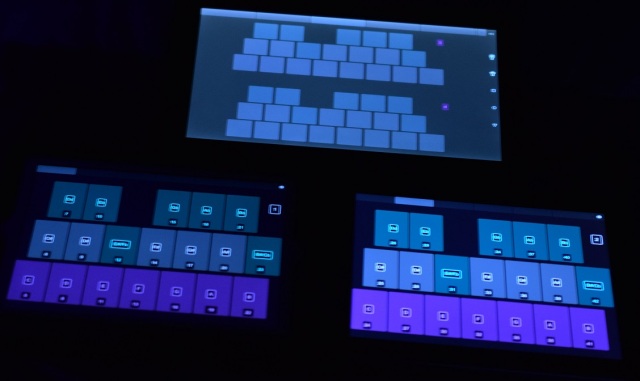What is it?
Two iPads and and RCA Maven running TouchOSC.
Why is that significant?
Because it’s a reconfigurable midi control surface.
Which is significant because?
Within a session or two I can draw up and deploy to hardware a usable, sensibly laid out MIDI key mapping for pretty much any practical (fewer than 128 notes in this case) tuning.
Which is significant because?
Because Fuck You, that’s why. There have been a few proud hardware synths and a plethora of soft synths that can handle alternative tunings. While that’s cool for sequencing, playing in a tuning that doesn’t consist of 12 notes on a keyboard that does sucks.
There are harmonic table keyboards and such. Playing a keyboard that has no specific visual representation of scale is heaps better than playing a keyboard that is showing you the wrong one. It’s still better to be able to play a representation of the frequency relations that, you know, represents the frequency relations you’re playing. It’s better still if you can change this representation on a whim, and in a heartbeat, rather than in an afternoon and in a garage.
How well does it work?
Linearly to how much you money you put into it. An iPad with a good midi interface runs
great. No dropped notes, transmits velocity (as determined by vertical position on the keys) fairly accurately, basically works as well as a tactile keyboard would. The cheapest Android tablet I could find transmitting midi over wifi sucks. Frequently dropped/hung notes and forget about velocity messages.
So how much does it cost?
In the interests of future proofing for at least a week I will say that it costs as much as many tablets you want to use cost. Those tablets must be able to handle a hardwired midi connection. That means, as of July 2106, they must be iPads paired with MIDI interfaces. You’ll also need to pay for the software. TouchOSC is 5$ per license, the alternative, Lemur, is 25$ per license.
Androids kinda work, as of Marshmallow they support MIDI over USB. They have, for a number of OS revisions prior, supported standard USB MIDI interfaces, but actually implementing that support was left to the individual software developers. As such, neither TouchOSC, nor Lemur support MIDI interfaces. Lemur will do MIDI over USB if you have a device running Marshmallow or higher, but you currently also need a device running OSX to parse and route what’s being sent into something usable.
*I expect the preceding paragraph to be obsoleted in a relatively inconsequential duration of time. I’m kinda sorry you read it. To put things into perspective, being able to play a software reconfigurable keyboard was scifi as fuck 10 years ago, now it’s possible to set up a pretty nice 2 or 3 interface one for the equivalent price of a new novelty synth using goddamn consumer components. At some point, probably sooner than expected, being able to do so will be effectively free.
Really, the cost mostly comes out of your soul for supporting Chinese labor practices, but if all this stuff were handmade in Northern California none of us would be able to afford it.
So how much effort is involved?
Surprisingly little. You get a stupidly overpriced USB female to apple proprietary cord, you plug your MIDI interface into that and you plug that into your iPad, or you get one of those iOS audio/MIDI interfaces and you plug that into your iPad. You connect and route the MDI out from the iPad(s) to your synth(s).
You get a copy of TouchOSC or Lemur through the app store. You set up the editing program for your app on your PC or your Mac (TouchOSC also has an editor which will run under linux, Lemur doesn’t [see*]). You figure out how you want to set up your tuning; how many notes you need over how many octaves, how you want the relationships between those notes represented, how you want things labeled, what colors you want everything to be, all that stuff and draw, copy, paste and configure it up.
How long that takes is dependent on too many factors to even estimate. It took me about a half a weekend and a few nights to get a 19TET keyboard set up. TouchOSC’s editor has a few faltering points, navigation through its input and display elements and parameter editing for groups of inputs/output could be a lot better but those are also easily fixable, so see *. Lemur’s editor is, I dunno, ask someone who uses it, it’s probably pretty o.k. once you figure it out, just about everything is.
Except for the actual art and craft of designing an interface, the entire process is fast and easy.
So what sucks about it?
That it isn’t tactile. Not being able to play without looking at your keys is really not cool. As is not being able to register strike velocity or aftertouch. It would be a deal breaker were it not that the alternative requires having a keyboard for each of the tunings you want to play in AND needing to first design and build or modify each of them. This is the best we’re getting until someone figures out something really clever with colloids or magnets.
The cost is, ehnn, not great, but totally reasonable for the magical technological marvel it is. The cost will also, I suspect, be pretty negligible in a year or three.


You _can_ get tactile feedback from your iPad instrument, using an acrylic or PETG transparent overlay with holes cut for the keys. I’ve done this with the Musix Pro program, with hexagonal key layout. Two shops that do inexpensive laser cutting are Ponoko and Polulu.
While the holes are not the same as buttons, they do give accurate positioning feedback. The templates can be thin also, .02 or .03 inch thickness.
LikeLike